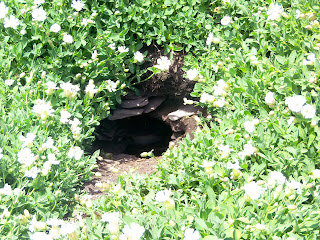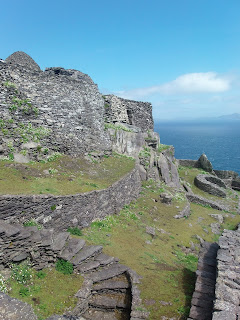Delightful I think it to be in the bosom of an isle, on the peak of a rock, that I might often see there the calm of the sea.
Anonymous Irish author, twelfth century
So I left you yesterday at the top of the 670 stairs.
"The largest of the Skelligs is Skellig Michael (Sceilg Mhichil) and was home to one of the earliest monastic settlements in Ireland. These monks of St. Fionan's monastery led simple lives and lived in stone, beehive shaped huts. They would descend the 670 steps early every morning and fish for the morning's breakfast. They would spend most of the day praying in the church, tending to their gardens and studying. These huts, which were round on the outside and rectangular on the inside, were carefully built so that no drop of rain ever entered between the stones. The monks left the island in the thirteenth century and it became a place of pilgrimage."
Once I passed that last path, I ran into this stone and the last steps to the entranced.
I rounded the corner and saw my friend Carol Eubanks' twin (See the gal in purple above)... You know how we all have twins out there in the world? Carol, your twin works at Skellig Michael as a guide. She just got back from yoga training in India and now spends two weeks on, one week off, living in this remote monastery 12 km off the cost of County Kerry, Ireland giving tours. Seriously. I talked to her for a while. She may have had a few years on you, but seriously EVERYTHING else was remarkably similar.
Here's a great view of Little Skellig from the monastery.
Here's a guy giving a lecture about the monastery.
 |
| Here is one of the beehive huts. There were about six in total. |
 |
| Check out the roof of the beehive hut. |
 |
| This was a ruin of a little chapel. You can see Little Skellig through the window. |
Surrounded by saltwater, fresh, drinking water was a priority. The monks built cisterns to catch and store rainwater. Here are a couple of examples.
I loved the stacked stones. On the huts the stones are stacked so well that the floors stay dry.
Here are three huts side-by-side. The one on the end is the first one I showed with the cool thingys sticking out of the roof. The second picture shows the same huts from behind.
We were free to explore all around the monastery. I went inside every single hut. They were dry and dark but your eyes adjusted immediately. Strangely, the inside floorplans were square, several had corbelled ceilings and some had bird's nests in the corners.
 |
| A doorway. |
 |
| An inside wall to show the squared corner. |
 |
| The ceiling. |
Here is another hut from above. Behind this one is a little graveyard.
All of these pictures are taken from quite a small area. I am not sure how this is coming across but from the above picture you can see nearly everything. They lived in very tight quarters.
Here is an aerial view that I found online.
Here's an aerial photograph of the whole island that I found online. I didn't get to see the lighthouse on that Northwestern side.
And another picture of Little Skellig.
There was a short stone wall around the monastery, so it was not particularly scary in the sense that you felt like you would fall off. It might have felt very different if it had been wet and windy (which I suppose is what it is like there most of the time). Below is a picture I took leaning over the wall.
 |
| More of the monastery. |
 |
| Stone steps. |
Here are a few attempts at some artsy photos.
Here is a different way out of the monastery. You will see the steps out and then a path down. In one of my last pictures of us leaving the island on the boat you can actually see the path down the island.
I started to head back down the hill at this point. We only had two hours to explore the island and I was hoping to spot a puffin. Lynne and I had purchased a couple of scones for the trip and I had BOTH in my backpack, so I needed to get down to refuel her as well! Here is the cliff and two boats fishing and waiting.
 |
| More cliffs. |
 |
| More fishing boats and sheer cliffs. |
 |
| Here was a puffin nest with a puffin in it, but you could barely see him/her. |
 |
| This is a "Where's Waldo" sort of thing. Can you find the cross? I met the photographer Michael Hermann on my walk down. He pointed the cross out to me. |
 |
| This was a cool backwards look as I was coming down. I don't think I was able to see the rugged jaggedy outcropings as I was concentrating on my way up. |
 |
| Another look back. |
 |
| Here I am almost where I started, at the path. |
 |
| And look who came out of his/her nest.... |
 |
| For a look around. |
 |
| The boat landing. |
 |
| Here are the fish our captain caught. He ended up giving us a few once we got back to port. |
 |
| Holly and her man! |
 |
| Leaving Skellig Michael. |
 |
| And back to port. |
































Breathtaking photos !!! Wish I could visit there.
ReplyDelete